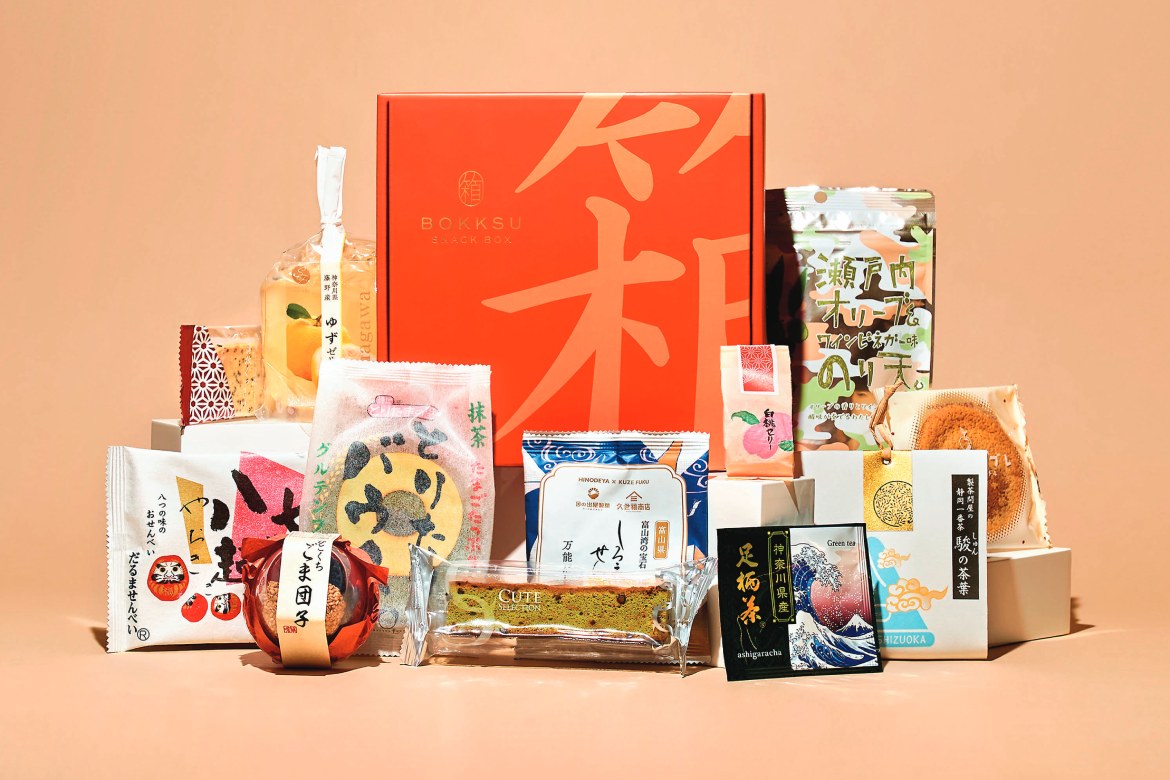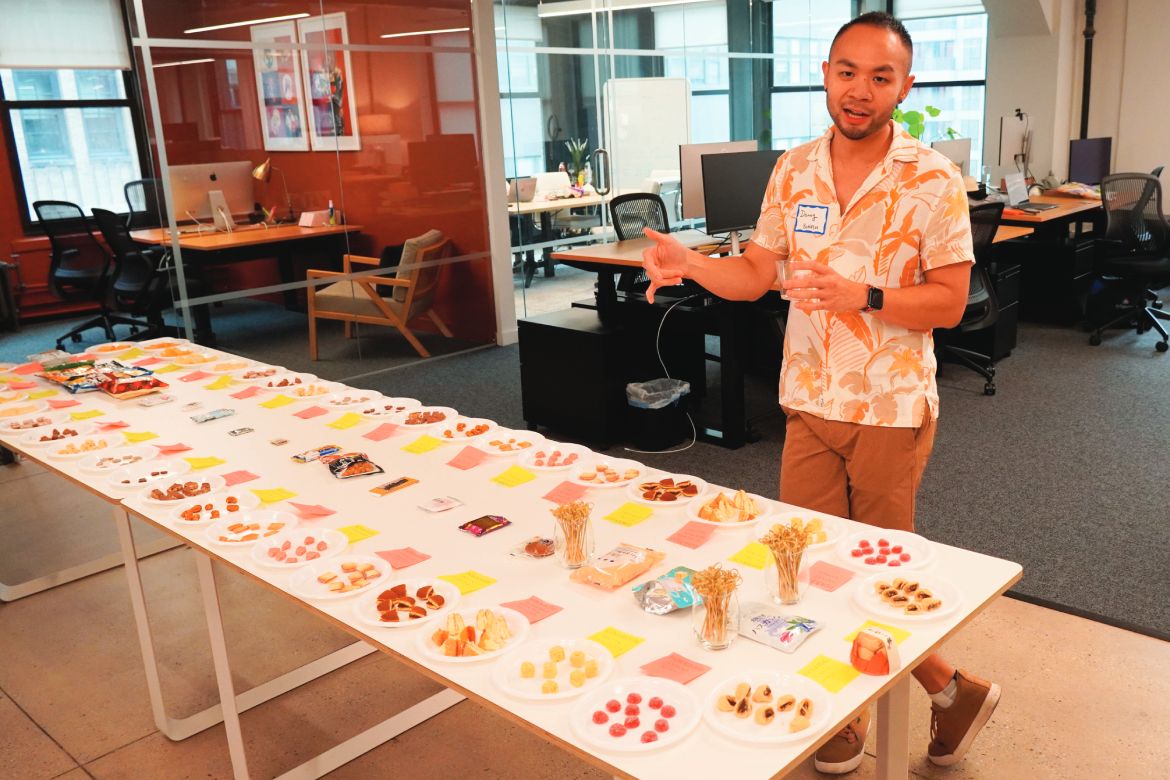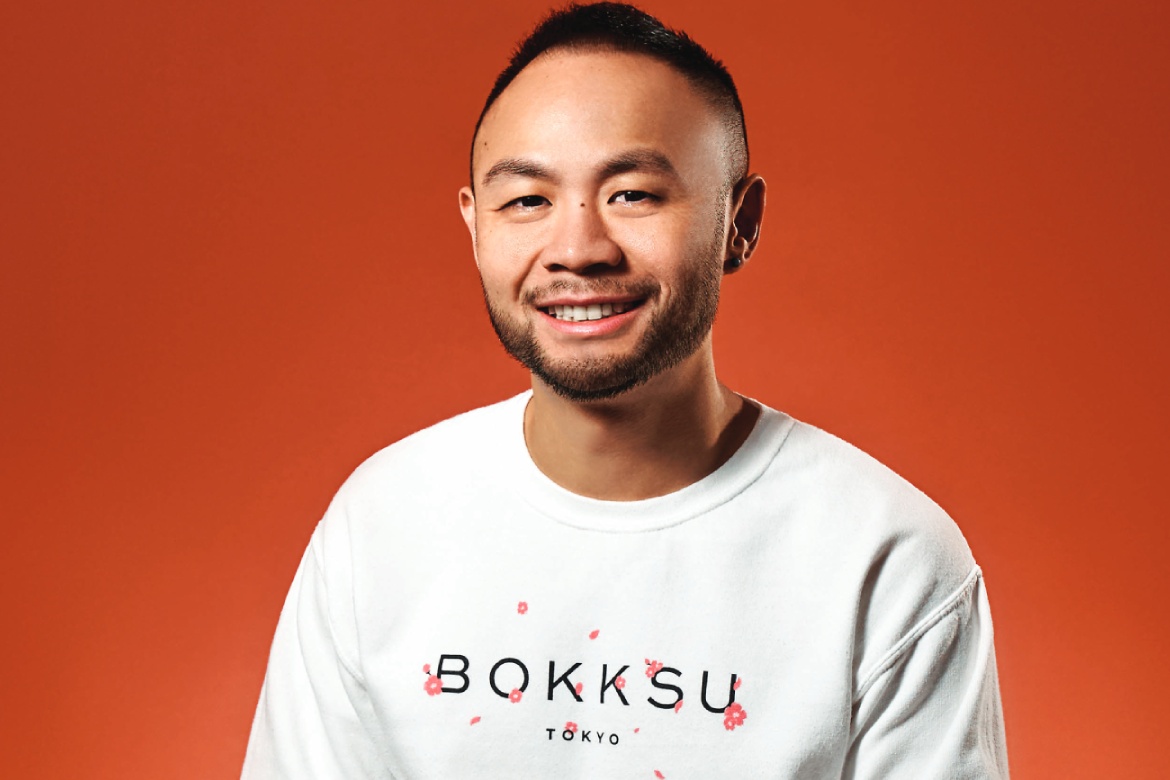Japan is a foodie paradise, with the most Michelin starred restaurants in the world, including a dozen rare, coveted three-star designations in 2023.
It came as a surprise to Asian American Danny Taing however, that this next level epicurean culture extended even to packaged snacks. One in particular proved an epiphany, he admits.
“A Hokkaido snack called Jaga Pokkuru,” he shares. “Jaga means potato, and they’re like these French fry sticks using salted and fried Hokkaido-grown potatoes. It’s crispy and tastes amazing, a simple snack, but it made me go, ‘wow, if snacks can taste this fresh and delicious…’”
Not only did this “eureka” moment ignite a passion for Japanese snacks, but planted the seed for Taing’s 2015 founding of Bokksu (bokksu.com), a monthly curated selection of often exclusive snacks and a tea pairing you won’t find from its competitors or in US Asian supermarkets,
Built around a theme, whether it be specific to prefecture or city, season, festival, or even color palate, the snacks from Bokksu are packaged in gorgeously designed, keepsake-worthy boxes with informative, glossy guides explaining each month’s selections (and how best to enjoy them). Partnering with Sanrio, Bokksu also offers a separate Hello Kitty-centric bimonthly box that is a perfect gift for fans of the character and its adorable Sanrio buddies. There is also an online boutique for purchasing popular individual items, specialty curations, including elegant cotton candy, and other goods.

Bokksu Snack Box (Photo by Bokksu)
Raised in New Jersey by Cambodian-Chinese parents who emigrated in 1979 to escape the Khmer Rouge, Taing has degrees in Psychology, Communication and Sociology from Stanford, but he admits he floundered career-wise before Japanese snacks ignited a passion and successful startup.
Maintaining Bokksu offices in both Tokyo and NYC, Taing currently lives in the latter’s Hell’s Kitchen neighborhood while his Japanese husband Shunsuke (they met twelve years ago in Japan and married in 2020) continues to reside in Tokyo’s Shinjuku district. In a major late 2023 development, Bokksu acquired competitor Japan Crate, which boasts a footprint in North America’s retail markets (and may lead to Bokksu snacks in North American stores).
From Bokksu’s Chelsea office, decked out with snacks including those in the process of sampling and vetting by Taing and staff, the bigtime foodie discussed Bokksu, some of the gayest, cheekiest, and strangest snacks he’s come across, his favorite Japanese regions and recommendations, and the best practices for navigating the gay scene in Japan.
How do you see Bokksu as fulfilling a childhood dream or goal? I understand you gave at least a couple of start-ups a try before this one.
All through my life, I didn’t have one main career goal. There was a period of maybe two years in late college when I thought I wanted to become a lawyer. I like reading and writing and can be argumentative, so I thought let’s give this a shot. I took the LSATs and applied to law schools. Thankfully I didn’t end up going to law school and dodged a bullet there because I don’t think I would have been a good fit. So Bokksu fills this career goal I never thought I had or needed. I never thought I’d become an entrepreneur. By the fact every month my job changes, that’s really exciting and fun for me because I get new challenges. I get to keep growing and learning and the company is changing and evolving so it fills this need that wasn’t satisfied at any jobs I had before.
What were some of the original names considered before you decided on Bokksu?
So many! I had a whole spreadsheet of different combinations of words, because after I came up with the idea and looked online there were over 20 competitors in this space with varying “Japan Candy Box” types of names. I thought of Edobox, because Edo was the original name for Tokyo and a time period in Japan. It’s easy, short, sounds fancy and Japanese, and I wanted something premium, to set myself apart from “Japanese Candy Box,” which sounds kind of cheap. I ruled out anything with snack or treat, too, so I could expand beyond snacks at some point. So Edobox and Bokksu were the main contenders.
Name aside, what specifically sets Bokksu apart from its competitors?
Several things. We were the first to do this kind of box, which is authentic Japanese snacks, and partnering with family businesses across Japan. All the others were doing the same thing, Kit Kat and Pocky types of curations, and a lot of times you could find those products in the USA. I’m a founder who is very passionate about our mission of bridging cultures and working directly with family businesses. And we are very obsessive about the quality of our products. We taste test everything that goes into our box to make sure the balance is good.
What’s the gayest snack you’ve ever seen? I know there are Japanese “penis festivals,” presumably with lots of phallic cakes and candies.
There are. We’ve never carried them for obvious reasons, our customer base might be a little too stimulated. We have a lot of families as subscribers! But the one that comes to mind right away is from one of our Hokkaido makers, Kitsune no Shippo. It translates to “Fox’s tail,” and it’s almost like a croissant baked in a tail-like shape, topped with white chocolate. It’s so cute and the packaging has a fox with a tail, it’s adorable and tastes really good. To me, that’s really gay.
What about snacks that are amazing but a little too alien or weird when it comes to Western audiences?
There’s this really popular traditional Japanese snack which is fried dough topped with brown sugar or different seasonings called karinto, and it’s quite tasty. Like a funnel cake, it’s usually curved and ridged and black or brown, and each piece looks like a piece of shit. Like fried, long turds. The first time I saw it in Japan I was like, you’ve got to be joking me, and I asked my Japanese friends, ‘you know this looks like a piece of shit right?’ They were like, that’s an unspoken thing even though everybody knows it. When we tried to put it inside a Bokksu box the customers lost it. They could not handle or make themselves eat it because it looked too much like feces. It was pretty early on, in 2016, and I put it in again in 2017 and every time it rated really low and customers had a lot of comments. It also doesn’t market well, you can’t photograph it to look good.
What are the worst Japanese snacks in your opinion?
For me the worst are kind of similar to Western snacks, where its lots of added sugar, really sweet, and generally for kids ages 2-10. They’re called dagashi for the most part, which is ‘candy snack,’ and too artificial tasting, and I can’t handle them too much.
What’s your most popular item to date?
A freeze-dried strawberry that has an infusion of liquid white chocolate, and a dark chocolate version. Both are fan favorites and people go crazy for them, so it’s in the first box every subscriber gets.
What specific month do you recommend people start with, either as a subscription or just as a one-off?
My favorite curation is always November’s. It’s Christmas holiday themed and generally Hokkaido themed, too, because it’s a winter wonderland and they taste really fresh and delicious. So the Hokkaido box around the holiday season.


Let’s discuss the selection process. How do you go about choosing each month’s items and are there ever any passionate arguments or fights over them?
It’s evolved a lot and changed entirely from the beginning. At first, it was just me tasting things by myself, and then as things went on we would have more teammates and sometimes taste together, but I still made the final decisions. Now the curation is first we taste them and narrow down. It’s also data driven after years of [feedback]. We used to get into pretty heated fights over certain snacks because if something doesn’t get into the box that month it might never, because it had to fit the theme. Especially savory snacks, which bring out emotions.
Are any of your suppliers LGBTQ?
None that are out. Snack making is a very traditional industry in Japan, some of the companies are over 300 years old. 99% of our snack makers are male as well, very few female snack makers. It’s changing little by little, but it’s a very old industry. So it’s actually even a really big deal that one of their main clients now is an out gay Asian American who speaks Japanese! And they all know [I’m gay]. I’ve been interviewed in Japanese newspapers and make it a point to say so. I asked my husband if there are out business leaders in Japan and he told me no, there are zero.
You managed to get Sanrio on board with a Hello Kitty collaboration series. Have you considered or tried doing the same with other iconic Japanese characters and companies like animation legends Studio Ghibli?
We want to do more but they take a lot of work, especially if ongoing. It’s more work than expected, but we are working on one with a noodle maker to create an evergreen box of ramen.
How about an LGBTQ Pride themed box?
Not as part of a subscription, but as a oneoff, yes. Tokyo Rainbow Pride restarted maybe 8 years ago, it stopped for a while, and Japan is building momentum for same sex marriage and visibility and I want to get involved in that. So a one-off rainbow box would be nice to have next April when Rainbow Pride takes place.
Snacks aside, which Japanese prefecture or city is your favorite?
Outside of Tokyo, which is an obvious choice, Hokkaido. It’s a northern prefecture, and it has the best food ever because it produces 25% of Japan’s agriculture from potatoes to wheat to dairy and seafood. All the sushi is from that area, so when you get sushi you can eat Michelin level for $20, and they have a corn and butter ramen. You can eat a different local food every day for a week. And everyone is so friendly and nice, it’s different from the polite distance of people in Tokyo. In winter, it’s famous for skiing, so go skiing or snowboarding, and you can also go to hot springs.
Is there an LGBTQ scene in Hokkaido the way Tokyo has its Shinjuku Ni-chome gayborhood, and any tips for navigating it?
Not really. Sapporo is the main capital city, and people know it for the beer and there are some gay bars, but no gay area and it’s not foreigner-friendly per se. You need to speak Japanese. It’s possible [to navigate the scene] without that, but in some ways it’s not respecting the local culture and people. If one can speak Japanese, everyone is super welcoming and friendly.
What are a few of your must-visits in Tokyo and Sapporo?
In Sapporo, there is a seafood restaurant called Koropokkuru. It has a lively atmosphere and the food is fresh and spectacular. Everything from the sashimi to the baked butter potato to the local Hokkaido delicacies are amazing. In Tokyo, Thermae-yu, a modern clean “super sento,” which means spacious public bathhouse in the heart of Shinjuku that has lots of different baths, steam room, sauna, an outdoor hot spring and more. The restaurant in the basement of this Sento is also surprisingly good. The gay bar King Tokyo is foreigner friendly and non-smoking indoors, while Bridge is a more traditional style gay nomiya, or bar.
Most gay nomiyas only allow Japanese speaking people, but the “mama-san” of Bridge (gay bar owners or managers are known as the “mamas”) is named Mitsuakisan and speaks decent English. He also loves Broadway and has come to NYC many times to see shows! It might feel awkward at first because it’s a bunch of middle aged gay Japanese men sitting around a counter, but if Mitsuaki-san is there, tell him Danny from NYC sent you, and he’ll be even more welcoming than he is already!
You might also enjoy Discovering Gay Tokyo


